by Bhanu Chopra
I recently wrote an in-depth crash course on the genre of flieger watches. A natural follow-up to that is this overview of French pilot’s chronographs known as Type 20, which were modeled on the German flieger chronographs of World War II manufactured by Tutima and Hanhart.
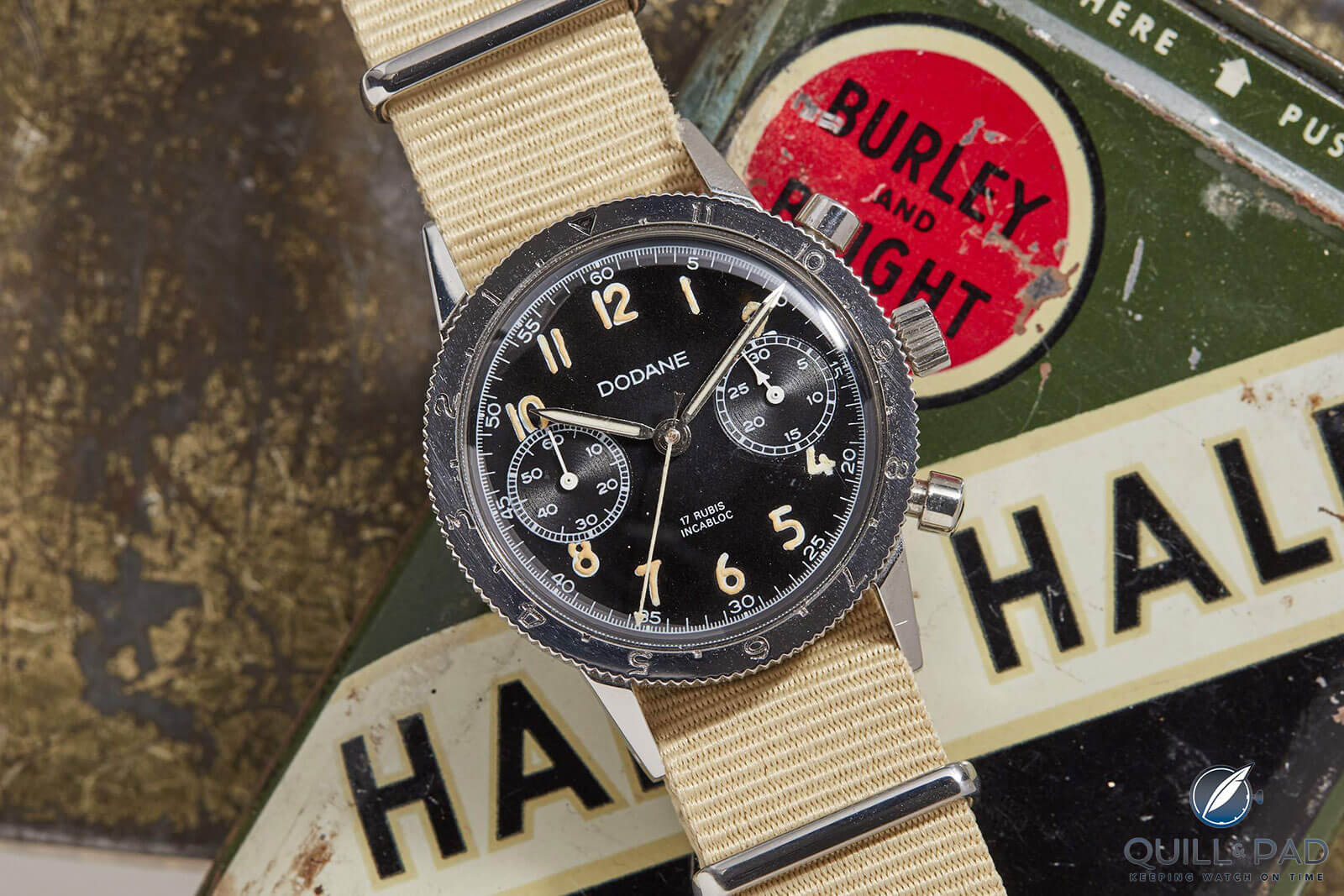
Dodane Type 20 (photo courtesy AnalogShift)
Breguet and Vixa were the first ones to supply Type 20 chronographs to the French military in 1950. Then, in 1954, Auricoste became the official supplier, followed by Dodane in 1960. The brands still manufacturing modern Type 20 chronographs are Breguet, Dodane, and Auricoste.
However, Breguet stands out from the others in terms of quality and horological significance.
Definition of Type 20
Type 20 is a specification by the French Ministry of Defense for their standard-equipment pilot’s wristwatches. Unlike the German flieger specifications, those for the French Type 20 are not clearly documented but are based on common characteristics shared by various manufacturers.
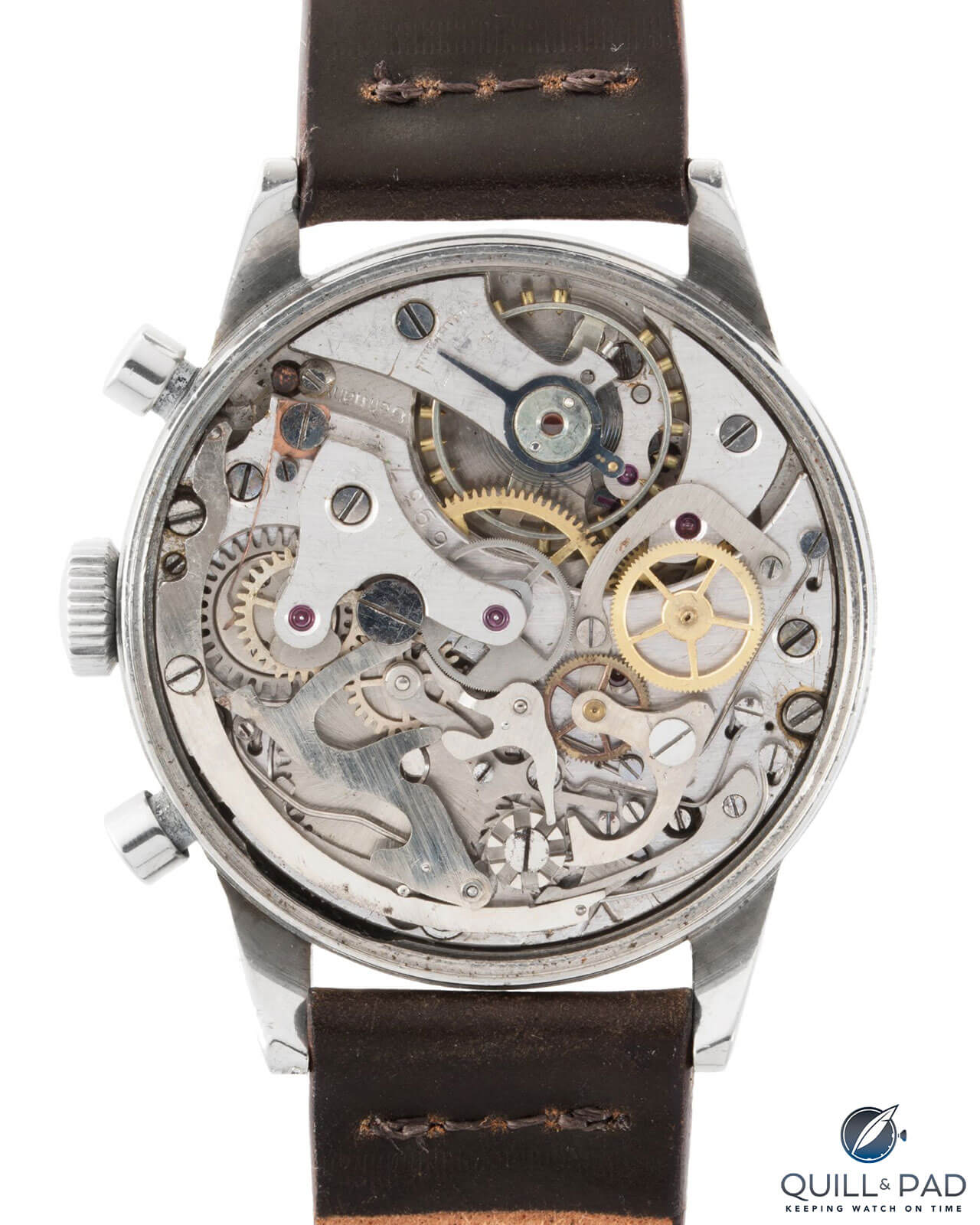
The movement of the Vixa Type 20 (photo courtesy Sean Song)
Type 20 characteristics appear to closely follow Hanhart flyback flieger chronograph specifications. These are as follows.
- Black dial with two registers at 3 and 9 o’clock that count up to 30 minutes
- Luminous hands and Arabic numerals
- A case diameter of approximately 38 mm
- Flyback function (retour en vol), which stops, resets, and restarts the chronograph with a single press of the lower button
- Bidirectionally rotating 12-hour bezel
- Accurate to within eight seconds per day
- Power reserve of at least 35 hours
- Ability to operate chronograph satisfactorily at least 300 times
An interesting marking on the case backs of the issued watches is “FG” (“fin de garantie”), which means “end of warranty.” The FG marking was followed with the date of the next service; the Type 20 watches had fragile movements, which meant they required service often.
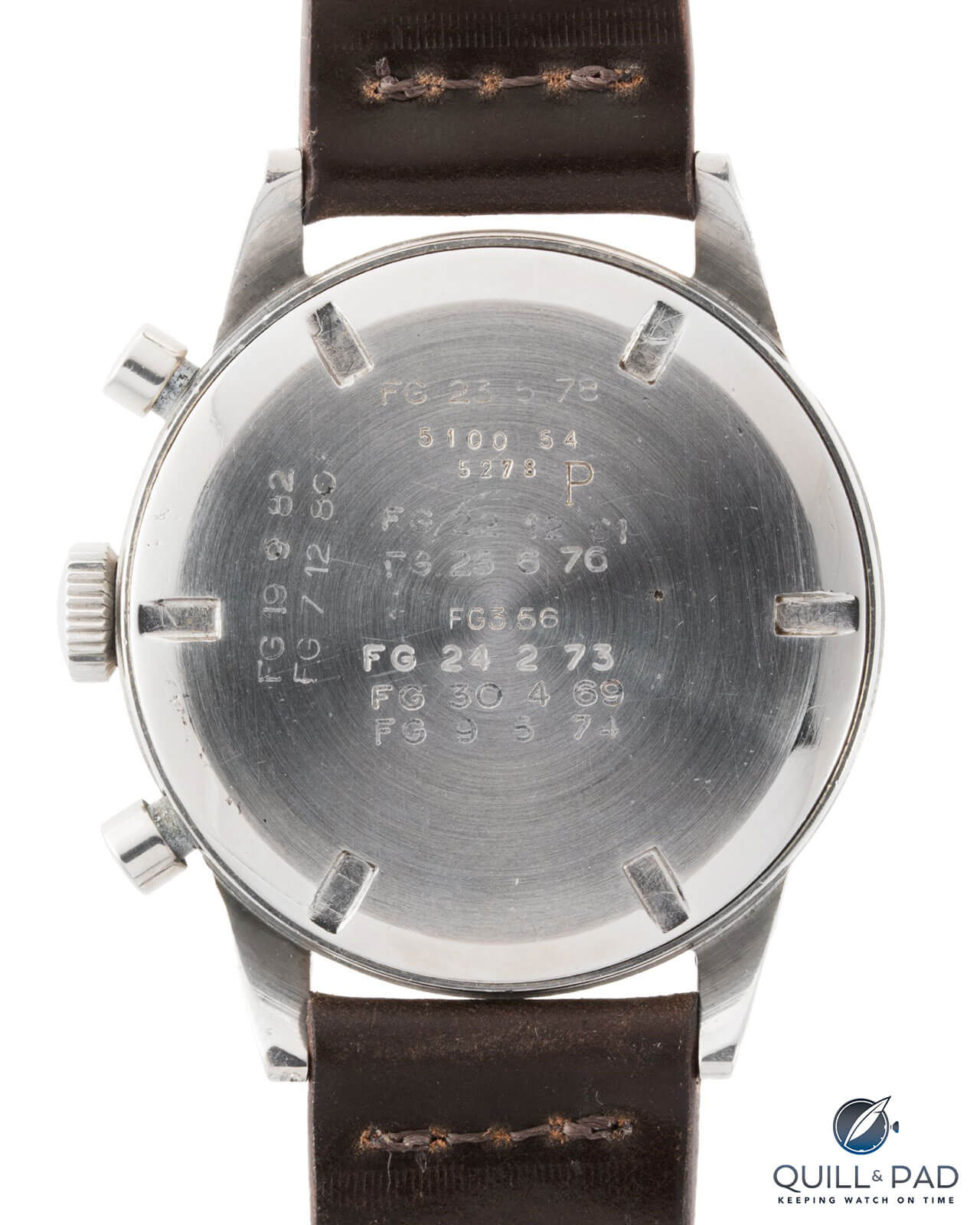
The prominent FG marking on the back of a Vixa Type 20 (photo courtesy Sean Song)
The FG marking distinguishes between military-issue and civilian watches.
Breguet Type 20 and XX
Montres Breguet, headquartered in Paris until 1976, was already a household name in France. Breguet became the official supplier of the Type 20 to the French military from 1954 until 1960, supplying variations of the flyback chronograph to the Air Force, the Naval Aviation Branch (Aéronavale), and the CEV (French flight test center).
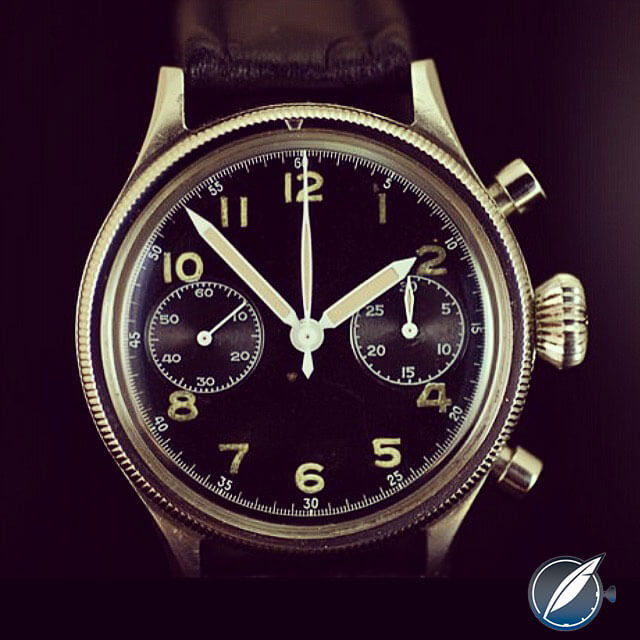
A Breguet Type 20 Reference 5101 with no logo on the dial (photo courtesy @Toiche)
Breguet also sold civilian versions of Type 20 from 1954 until 1970, which, according to Breguet, is why the slightly differentiated Type XX name came into use. It designates civilian models.
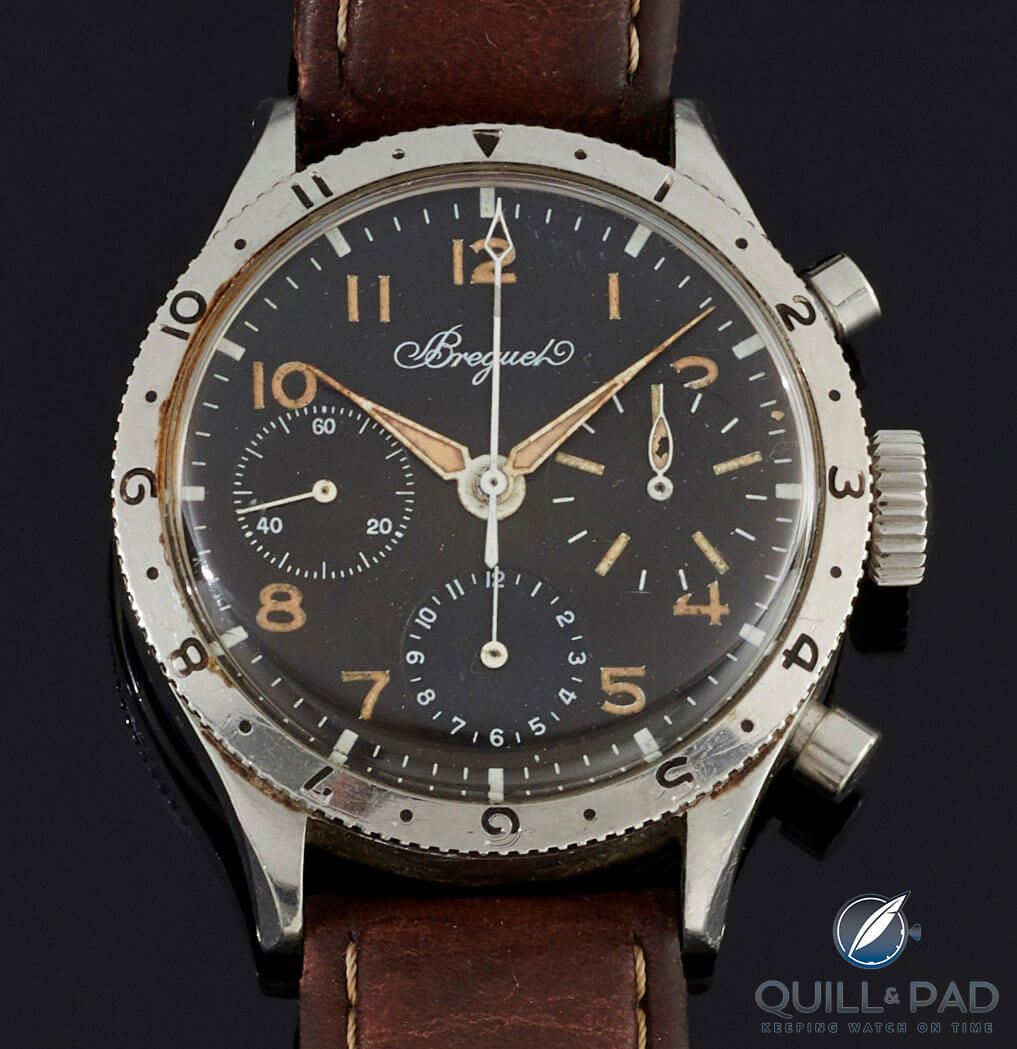
A 1957 Breguet Type XX from the Breguet Museum (photo courtesy Bruno Simon/Breguet)
The Breguet Type 20 was housed in a stainless steel case with screwed case back and powered by a Valjoux 22 movement with a flyback module.
Most Breguet Type 20 chronographs came with a 30-minute counter, but the brand also made chronographs with a 15-minute counter for Aéronavale and CEV.
There were a few variations of the crown shape, the most prominent being the large oignon-style crown. The hands varied between syringe-shaped and baton-shaped luminous shapes.
The earliest Type 20 models did not come with a brand logo on the dial, but the civilian versions (Type XX) did have the Breguet logo.
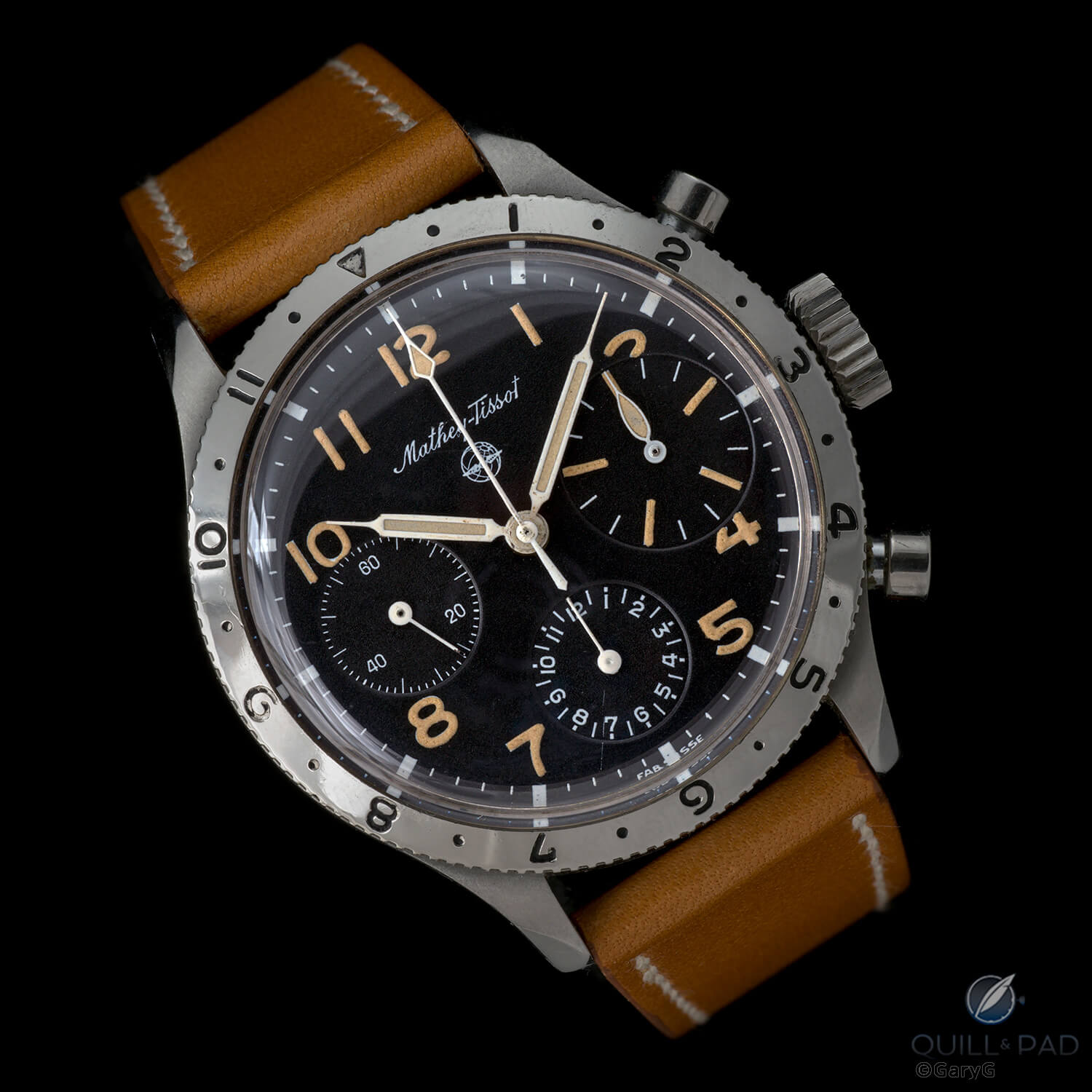
Mouthwatering: the Mathey-Tissot big eye Type 20 belonging to GaryG
An interesting fact about earlier Breguet Type 20 watches (also known in Type 20 parlance as the “first generation”) is that they were subcontracted to Mathey-Tissot, who manufactured the chronographs per specification. Mathey-Tissot also made and sold Type 20 chronographs under its own brand name for civilians that were identical to those bearing the Breguet name.
Quick Facts Breguet Type 20 First Generation (Reference 5101/54)
Case: 38.5 mm, stainless steel
Movement: manual winding Valjoux Caliber 222, 17 jewels, 2.5 Hz/18,000 vph frequency, 40 hours power reserve, movement dimensions 31.3 mm x 6.4 mm, monometallic balance, Breguet balance spring
Functions: hours, minutes; flyback chronograph with 60-second and 30-minute totalizers
Years of manufacture: 1954–1960
Auricoste Type 20
Auricoste was well known for manufacturing marine chronometers since the 1800s. After World War II, Auricoste began collaborating with Patek Philippe on an electro-mechanical timekeeping network for the French Navy’s warships.
Auricoste won the contract to deliver more than 2,000 Type 20 watches to the French Army between 1954 and 1955. Unlike Breguet, the Auricoste chronographs had the brand logo on the dial. The cases were made of stainless steel, chrome-plated copper, or aluminum.
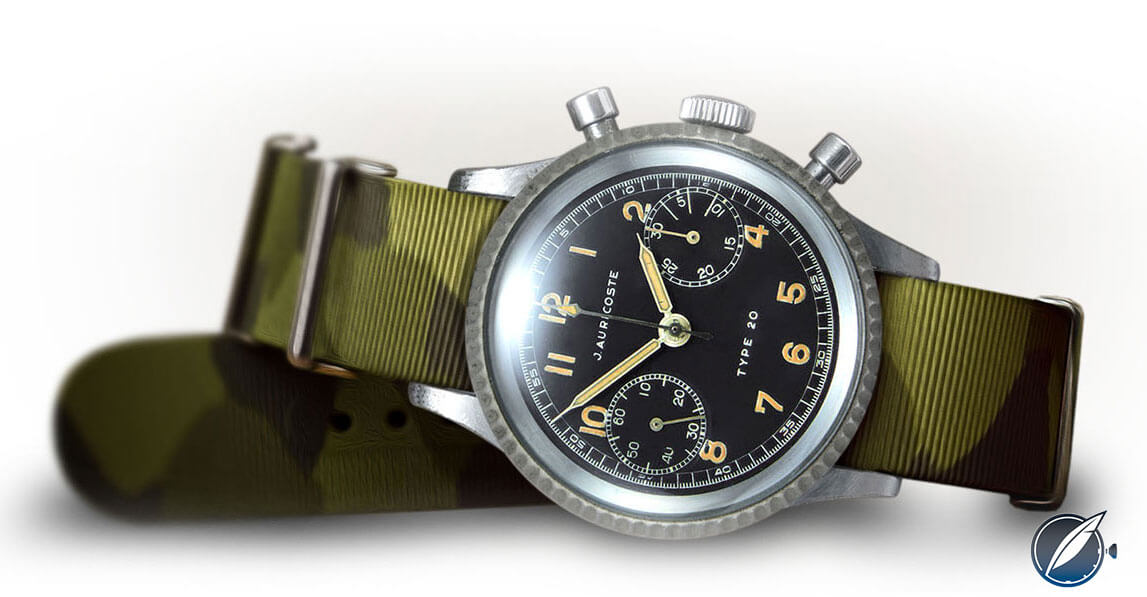
Auricoste Type 20
The Auricoste Type 20 chronographs were also sold to the Argentine Air Force and the Royal Moroccan Air Force, whose pilots were training in France. The Argentinean pilots wore the Type 20 watches during the Falklands War against the United Kingdom in 1982.
Quick Facts Auricoste Type 20
Case: 38 mm, steel, chrome-plated copper, and aluminum
Movement: manually wound Auricoste Caliber 2040 based on Lémania Caliber 15TL, 17 jewels, 2.5 Hz/18,000 vph frequency, 36 hours power reserve, movement dimensions 33.3 mm x 6.5 mm, Breguet balance spring, Incabloc shock protection
Functions: hours, minutes; flyback chronograph with 60-second and 30-minute totalizers
Years of manufacture: 1954–1955
Vixa Type 20
Vixa was named after a late president of Timex Watches France; Timex had a factory in Besançon until 1960. However, the Vixa Type 20 was manufactured by Hanhart in 1954.
After World War II, Germany’s Black Forest was part of the French Occupation Zone. As part of German reparation payments to France, Hanhart produced chronographs under the Vixa brand name for the French forces – much the same way Stowa produced watches for the French Army.
The similarities between the Hanhart and Vixa chronographs like the fluted bezel, which is a distinguishable feature of Hanhart watches altogether, are easy to see.

Vixa Type 20 (photo courtesy Sean Song)
Approximately 4,000-5,000 Vixa Type 20 chronographs were supplied to the French Air Force.
Quick Facts Vixa Type 20
Case: 39 mm, stainless steel
Movement: manually wound Hanhart Caliber 4054 (based on Hanhart Caliber 40), 17 jewels, 2.5 Hz/18,000 vph frequency, 36 hours power reserve, Breguet hairspring
Functions: hours, minutes; flyback chronograph with 60-second and 30-minute totalizers
Years of manufacture: 1954–1960
Dodane Type 20
Dodane was founded by Alphonse Dodane and his father-in-law François-Xavier Joubert in 1857 in La Rasse, primarily to produce ébauches (movement blanks) for other watch companies.
It was the second generation led by Alphonse Gabriel Dodane who began the specialization in flyback chronographs and equipping fighter jet dashboards with onboard chronographs.
In 1929, Raymond Dodane (third generation) relocated the factory to Besançon to pursue more traditional watchmaking. The company manufactured approximately 5,000 Type 20 and Type 21 chronographs from the 1950s until the 1980s.
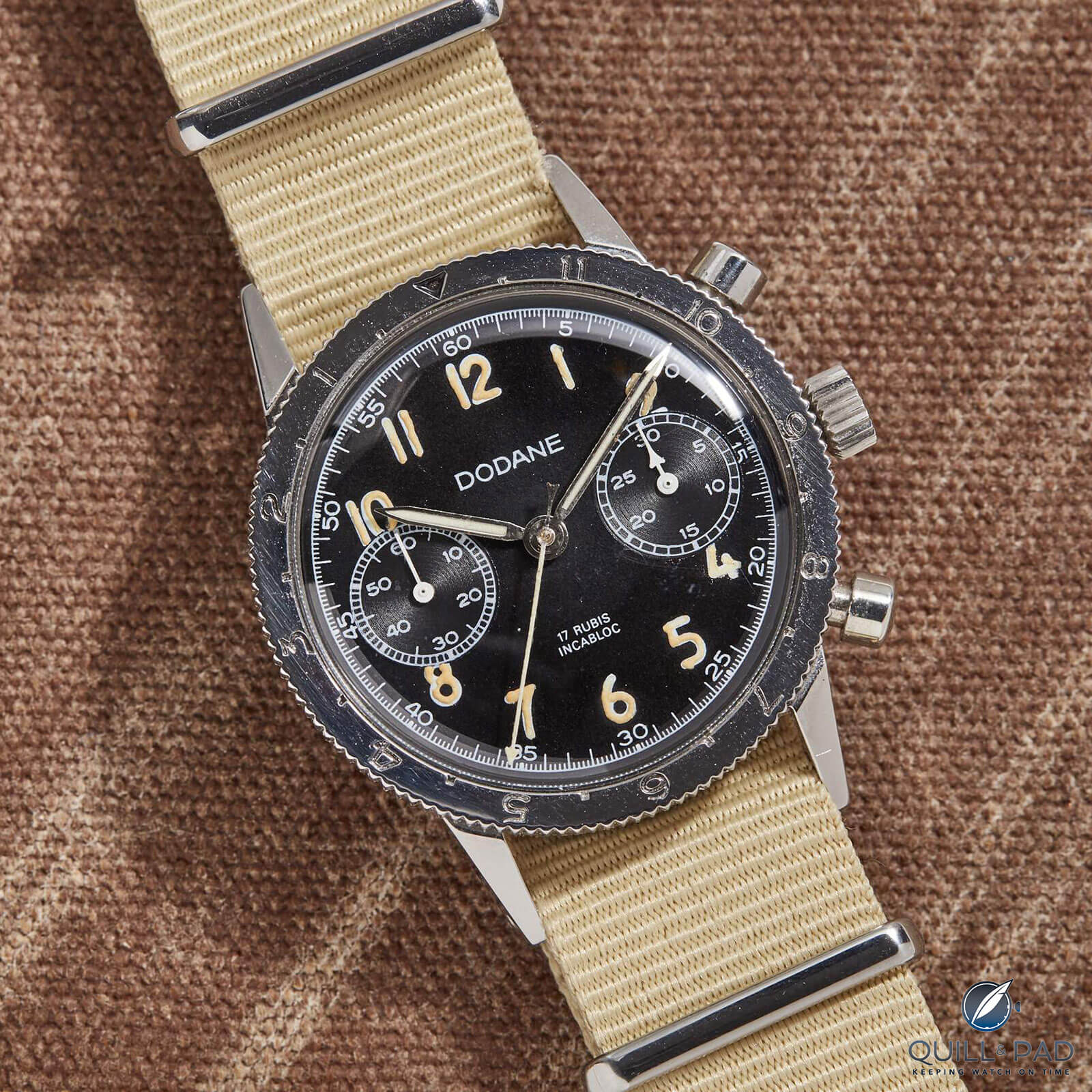
Dodane Type 20 (photo courtesy AnalogShift)
Dodane also sold Type 20 watches under other brand names like Airain and Chronofixe.
Aside from manufacturing watches for the French armed forces, Dodane performed repairs on all the Type 20 and Type 21 watches used by the various arms of the French military. Dodane became one of the approved suppliers to NATO as well.
Dodane primarily used the Valjoux ébauche in its watches (Valjoux Caliber 22 in the Type 20 and the Valjoux 72 in the Type 21). All the cases were made in stainless steel with screw-in case backs and countdown numbers on the bidirectionally rotating bezels.
Quick Facts Dodane Type 20
Case: 37 mm, steel
Movement: manually wound Valjoux Caliber 222, 17 jewels, 2.5 Hz/18,000 vph frequency, 40 hours power reserve, movement dimensions 31.3 mm x 6.4 mm, Breguet balance spring
Functions: hours, minutes; flyback chronograph with 60-second and 30-minute totalizers
Years of manufacture: late 1950s–early 1960s; Type 21 until 1970
Type 21
The French Ministry of Defense slightly modified the Type 20 specifications to improve the quality and usability of the chronograph to become the Type 21.
While most of the features remained the same between the Type 20 and Type 21, the latter required a more robust movement to decrease maintenance costs; some new features included a countdown bezel and a higher water resistance rating.
Dodane became the sole supplier of the Type 21 as Breguet’s watches became too expensive for the French armed forces. Dodane used Valjoux 720 movements for both military and civilian chronographs and sold them under the Airain, Dodane, and Chronofixe brand names.
Where are these manufacturers now?
Cédric and Laurent Dodane (fifth generation) re-established business under the brand name Dodane 1857 in 2013.
Today, the company produces Type 21 and Type 22 watches using modified ETA Valjoux automatic movements as well as analogue and digital watches powered by quartz movements.
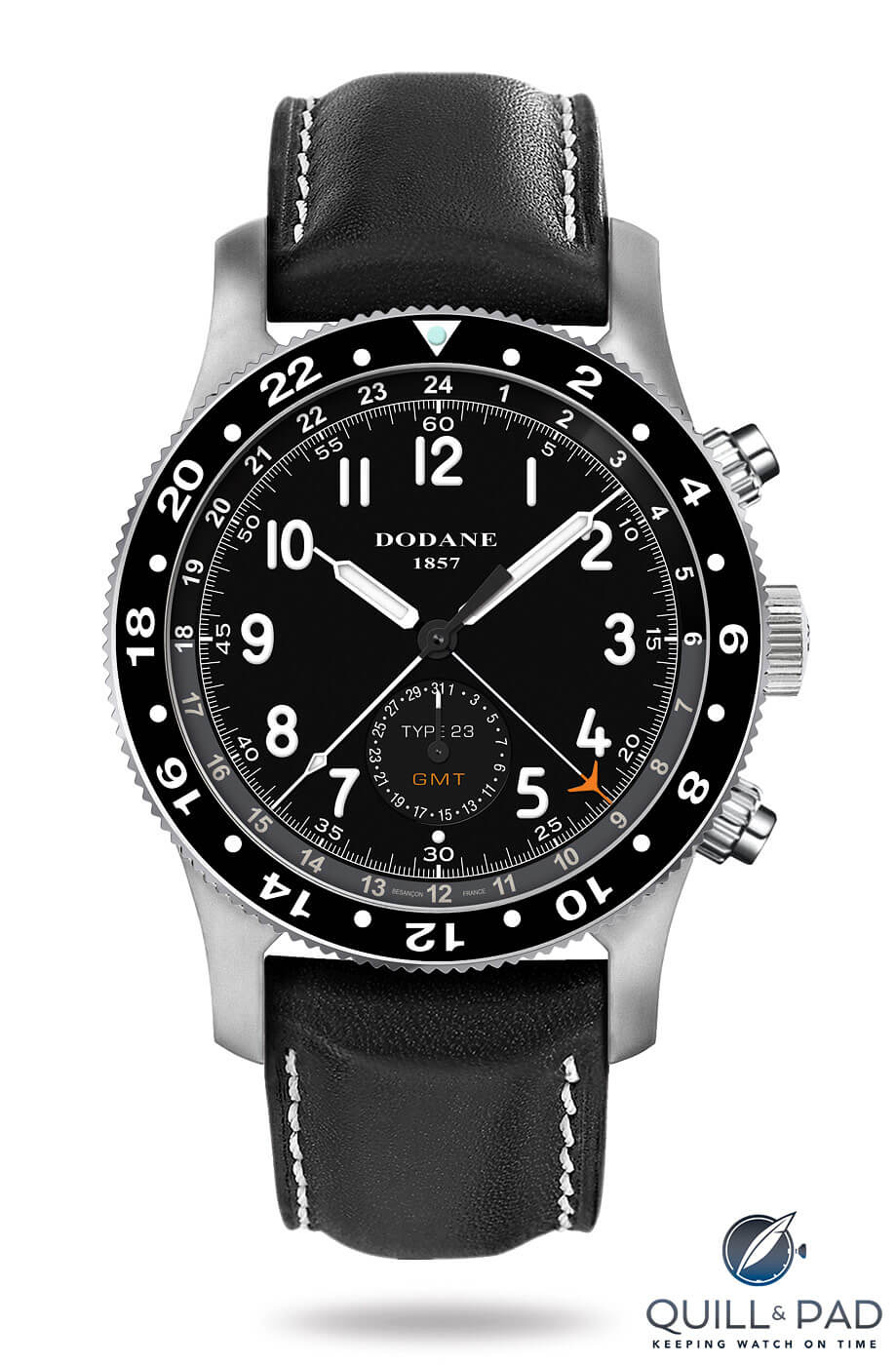
A modern Dodane Type 23 from 2015
Auricoste now produces modern Type 20 watches powered by ETA movements with Dubois Dépraz chronograph modules.
Vixa was resurrected few times under different owners, but currently does not offer any Type 20 watches.
Breguet’s modern Type 20 history
Breguet has become the most prominent modern Type 20 watch manufacturer and is popular with both aviation and general watch enthusiasts.
Breguet was acquired by Chaumet in 1970, at which time the second generation Type 20/Type 21 watches were introduced with unidirectional anodized black bezels and cases with squarer lugs.
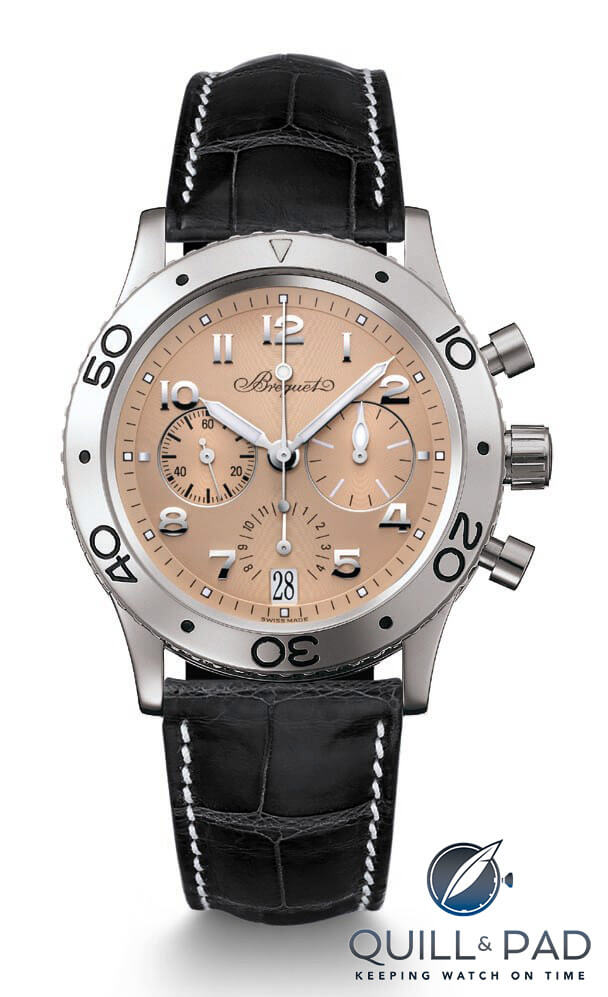
Breguet’s Type XX Transatlantique Reference 3827 in platinum with salmon-colored dial was made in 1998 in a limited edition of 90 pieces
In 1995 Breguet released the third-generation Breguet Type XX Aéronavale Chronograph, which is still in the brand’s current catalog. Reference 3800ST/92/9W6 is powered by automatic Caliber 582, which is based on Lémania Caliber 1350 with an added flyback module.
In 1999, the Swatch Group acquired Breguet, including the Lémania movement manufacture, which it subsequently annexed and renamed Breguet Manufacture.
Since then, Breguet has released variations of the Type XX in different metals and complications. Most recently Breguet introduced the sixth-generation Type XXII with a lightweight silicon flat balance spring beating at 10 Hz.
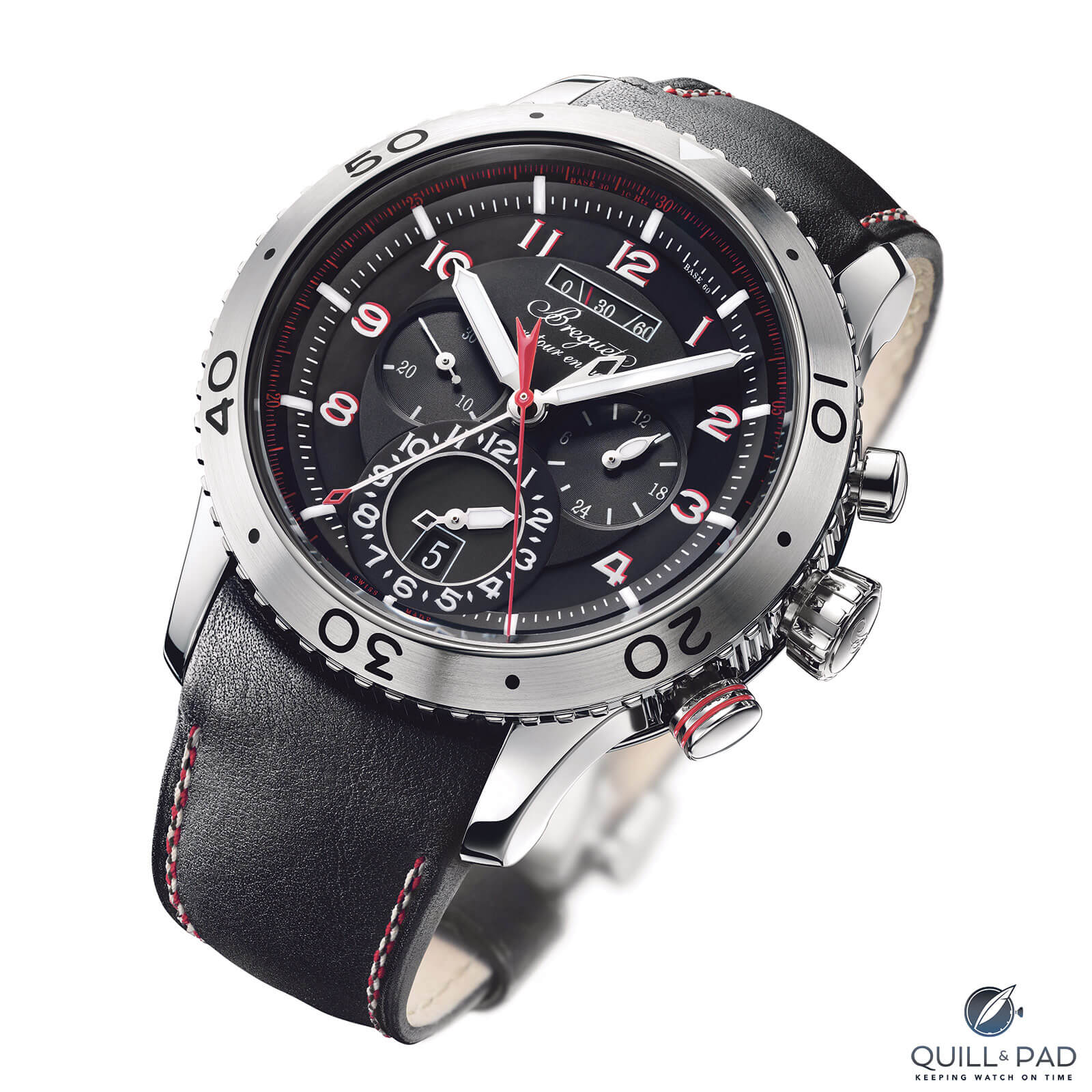
Breguet Type XXII Reference 3800ST from 2010
While the dialogue for mechanical innovation and evolution of the Type XX has been carried forward in watchmaking, the use of mechanical watches in France’s air force has remained redundant with today’s abundance of affordable quartz watches.
However, there is a rise in demand for Type 20 watches within the ranks of vintage watch collectors. Chris (@toiche), who is an avid Type 20 collector, tells me, “the first generation of Type 20 from the mid-50s have repair stamps on the case back up to 1985; it is absolutely stunning to have such a long life in the military as daily gear.”
Quick Facts Breguet Type XXII (Reference 3800ST)
Case: 44 x 18.05 mm, stainless steel, bidirectionally rotating bezel
Movement: automatic Breguet Caliber 589F, 28 jewels, 10 Hz/72,000 vph frequency, 40 hours power reserve
Functions: hours, minutes, seconds; date, second time zone, flyback chronograph
Date of introduction: 2010
Price at launch: $18,200
You may also enjoy:
Why I Bought It: Vintage Mathey-Tissot Type 20 Big Eye Chronograph
Why I Bought It: Kudoke Flieger Concept (KFC)
Leave a Reply
Want to join the discussion?Feel free to contribute!





















































Wow! So much research must have gone into this amazing review. Really appreciate all the information. My memory being what it is, I shall bookmark this page to use as a reference again and again!
Cheers and Thank You,
Carl
Thank you for the positive feedback, Carl! The best part about writing is the research and sharing that knowledge with fellow enthusiasts.
I’ve been on a bit of a Type 20 kick recently so I’m happy to see this cross my inbox. Mathey-Tissot produces a quartz Type 21 with pretty close visual reference to the original (at least to my eye; there are distinct differences, of course), which I guess is a …homage to its own earlier work? (Also, I don’t know if Mathey-Tissot is a continuation of the same historic company, or a resurrected name under different owners, etc..)
Hi James,
Thanks for reading the article. I am on a Type 20 journey as well. Mathey-Tissot remained a supplier to other brands under various ownerships until the 1990s. In the 2000s it is now making quartz and entry-level mechanical watches with designs inspired by several historical watches. Their manufacturing is partially done in India.
Aside from Breguet, the most famous, Dodane and, most recently, Airain are perhaps interesting.
Oh! I didn’t know that about current Mathey-Tissot production. Thank you! I’m definitely curious about the Airain, and I hope it’s successful.
I recently gathered some info on the Type 20 for a friend and fellow enthusiast. I wish I’d waited a few weeks and I would have simply sent him this piece! Thank you for your work!